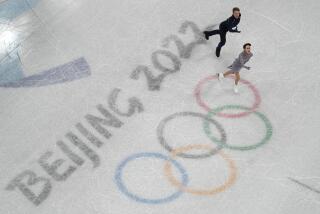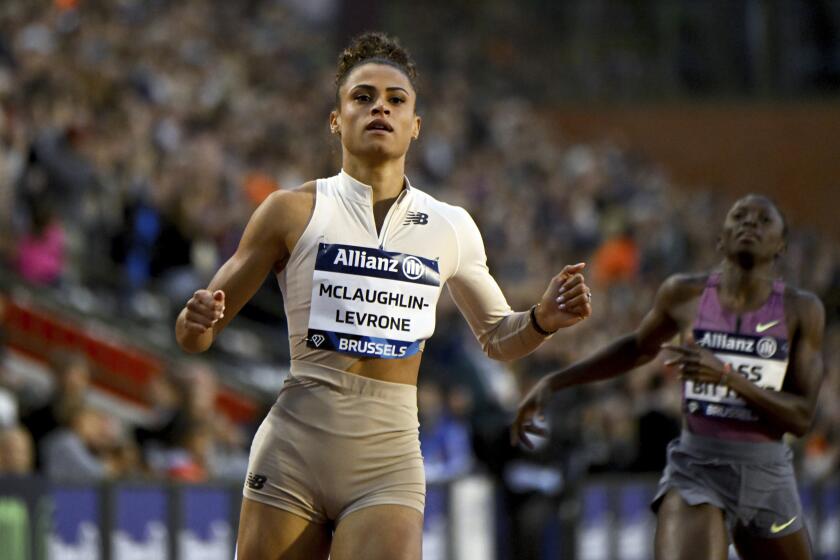WINTER OLYMPICS : SLICK AS ICE : Both Speed Skaters and Records Should Be Falling at New Indoor Facility
- Share via
CALGARY, Canada — For the first time, Olympic speed skating events are going to be held indoors, which means two things:
--World records are virtually certain to fall.
--There are going to be some people falling on the ice.
The Olympic Oval, almost as long as two football fields, cost $40 million to build. Not only is it big, but it is also very fast.
“I could see a world record in every event,” said U.S. speed skater Dan Jansen.
There were a number of falls in the turns--including one by Jansen--when the world’s top speed skaters competed at the oval’s pre-Olympic event, the Calgary World Cup in early December. The ice is very soft, especially in the turns, were skaters must switch to finesse. On the straightaways, strength and speed are paramount.
“It is not only soft, but very fast,” said Karin Enke Kania of East Germany. “It’s difficult to keep the high speeds in the corners. If it’s difficult for women, it’s much more difficult for men.”
The oval is connected to the University of Calgary’s physical education building. Designed by the Calgary firm of Graham McCourt Architects, the oval has won three Canadian awards for construction, design and engineering.
The oval has a 400-meter three-lane speed skating track. Skaters compete in pairs, using only the two outside lanes. The farthest outside lane is five meters wide, the middle lane four meters.
“The lanes don’t seem very big,” American Nick Thometz said.
Presumably they’re big enough, but maybe they won’t prove to be safe enough. Eric Heiden, who won five gold medals at the 1980 Lake Placid Games, believes there may be some disadvantages to the oval.
“It’s pretty dangerous, skating indoors,” Heiden said. “You’re at a high speed, and if you fall, you hit the boards pretty quick. And you’re usually out there (in practice) with a pack of other skaters, and there’s a lot of pushing and shoving. But as far as a spectator sport, I think it’s got a lot of potential.”
There is great potential for world records, too. In just about any race, the winning time could be a world record. If it isn’t, it may not be the winning time.
“To win the gold medal, we have to skate the world record,” Kania said. “We know this.”
Kania is the best the world in both the 1,000 meters and 1,500 meters, but the United States hopes to challenge her with Bonnie Blair. The top U.S. female skater at 500 meters, Blair has been working on her longer distances and seems to have a realistic chance--and even her coach says that is because of the indoor track.
“If Kania is skating well, there isn’t anyone who can beat her,” said U.S. Coach Mike Crowe. “But Bonnie is the only one with a shot at her in the 1,000. And this is the only place she’d have a shot at her. The speeds are higher indoors, so there is a greater chance of (Kania) missing a stroke. She could make a mistake in a corner. Bonnie’s turns are always solid and she accelerates coming out of them.”
More to Read
Go beyond the scoreboard
Get the latest on L.A.'s teams in the daily Sports Report newsletter.
You may occasionally receive promotional content from the Los Angeles Times.






